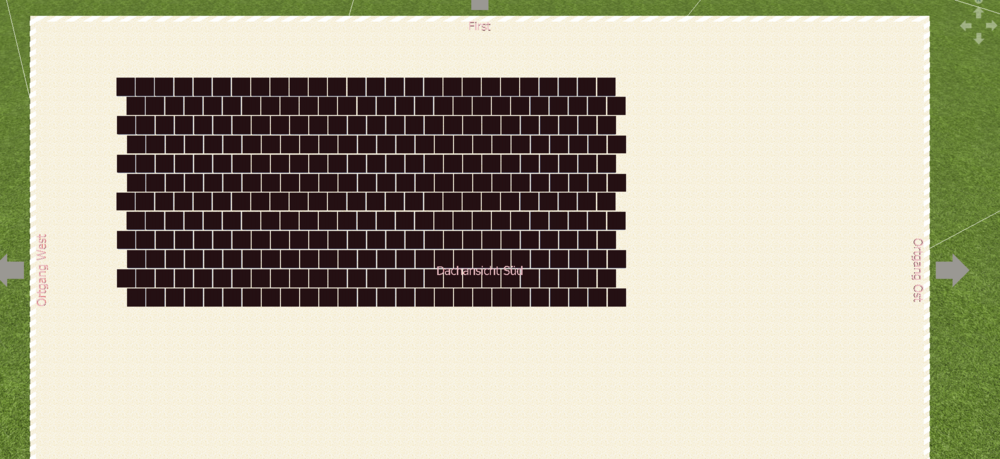-
Posts
1,853 -
Joined
-
Last visited
-
Days Won
173
Everything posted by developer_mh
-
Hallo Rajan, ein Lastprofil für ein Schwimmbad haben wir leider nicht in PV*SOL, nein. Es gibt zwar ein Lastprofil "Hallenbad", aber das ist ziemlich alt. Eine gute Quelle für solche speziellen Lastprofile haben wir leider auch nicht. Vielleicht können die Stadtwerke weiterhelfen? Viele Grüße, Martin
-
Hallo Marco, da bist du doch schon auf dem richtigen Weg! Nur macht es tatsächlich einen Unterschied, ob man die Gesamtkapitalrendite in monatlicher oder jährlicher Auflösung rechnet. Deine Tabelle müsstest du dementsprechend von Jahren auf Monate umstellen. Viele Grüße, Martin
- 4 replies
-
- gesamtkapitalrendite
- interner zinsfuß
-
(and 1 more)
Tagged with:
-
Hallo Johannes, ja, im Marktprämienmodell ist die Direktvermarktung sozusagen schon mit eingepreist. Der gesondert eingebbare Preis für die Direktvermarktung bezieht sich auf die Zeit nach dem Ende des Einspeisetarifs. Viele Grüße, Martin
- 4 replies
-
- direktvermarktung
- wirtschaftlichkeit
-
(and 1 more)
Tagged with:
-
Hi Christopher, the first thing that strikes me is that in your screenshots the decimal values are left aligned, whereas all numbers should be right aligned. Could you check the inputs again? Did you copy and paste the values perhaps? Perhaps there was some illegal character included that PV*SOL doesn't recognize. Kind regards, Martin
-

Simulation for Fronius Symo Gen 24 *10 kW with BYD batteris
developer_mh replied to Usama Alfadel's topic in PV*SOL
Hi Usama, yes, if you have this one device in reality, say a Fronius Symo Gen 24 10 plus, a combined PV and battery inverter, you should definitely choose the same device twice in PV*SOL, once as a PV inverter, once as battery inverter. In the financial calculation you only enter the price of the one device. The energy losses are not higher, since both the PV inverter losses as well as the battery inverter losses happen in a real device as well. Hope that helps, kind regards, Martin -
Hi GenDev, no, you can't place the modules with an per-row-offset automatically, just manually with copy and paste. But since you can copy whole rows, it shouldn't take too long. The stringing should work automatically however. According to your drawing you will have to divide the module area into two halves by selecting the modules and adding them to the "Define Module Areas" dialog. Then configure them to an inverter. Afterwards you can choose the cabling starting point, type and direction. I guess that "meander" should do the trick in your case. Hope that helps, kind regards, Martin
-
Hallo, die Prozentabangabe bezieht sich auf die installierte DC-Leistung der PV-Module (in kWp). Beste Grüße, Martin
-
Hallo Jürgen, hier gibt es Infos zum Import von eigenen Lastprofilen: https://help.valentin-software.com/pvsol/de/navigationsseiten/verbrauch/#gemessene-verbraucher Beste Grüße, Martin
-
Hallo Johannes, vielleicht hilft dieser Thread hier im Forum weiter: Wenn nicht, gerne nochmal nachfragen. Beste Grüße, Martin
- 4 replies
-
- direktvermarktung
- wirtschaftlichkeit
-
(and 1 more)
Tagged with:
-
Hi Craig, if you wish to send your proect file, you can do so here in the forum as attachment of a private message to me. Or you can send an email to our technical support: https://valentin-software.com/en/support/technical-support/ Kind regards, Martin
-
Hi GenDev, this is possible, yes. Solar tiles are not the standard use case in PV*SOL, but you can quickly get satisfying results. You should firstly create a PV module in the size of one of your solar tiles. Then place a first row of the tiles on the roof, copy it and shift the copy half a width sidwards. Then copy both of those rows and place them underneath. Then copy those four rows and place them underneath as well. Like this you can get the roof filled very quickly: The stringing can then be done like with every other module array, very easily. If you need further assistance, pease don't hesitate to ask. Kind regards, Martin
-
Hallo Marco, die Gesamtkapitalrendite händisch nachzurechnen, wird wahrscheinlich etwas mühselig. Die Berechnung beruht nämlich auf den Monatswerten. Wahrscheinlich ist das auch die Information, die zum erfolgreichen Nachrechnen in Excel noch gefehlt hat? Beste Grüße, Martin
- 4 replies
-
- gesamtkapitalrendite
- interner zinsfuß
-
(and 1 more)
Tagged with:
-
Hi freshwater84, unfortunately it is not possible to have the dynamic surplus consumption only be available for some months per year. You can simulate thermal systems with heating rods in PV*SOL directly, however, you then can't simulate electric vehicles at the same time, I am afraid. The only idea that comes to my mind is to take the monthly energy consumption from the dynamic surplus consumer from the months May to August and add them to the grid feed-in. You would have to do those calculations manually though. Kind regards, Martin
-

Simulation for Fronius Symo Gen 24 *10 kW with BYD batteris
developer_mh replied to Usama Alfadel's topic in PV*SOL
Hi Usama, I guess you are already trying to do it the right way. It is just that in PV*SOL, the PV inverter and the battery system is always displayed and configured as two separate devices, even though in reality both could be in the same device. So just choose the same device as PV inverter and battery inverter, and all should be fine. If you have doubts, you can also send me your project file here in the forum, as private message. Hope that helps, kind regards, Martin -
Hallo Lukas, leider ist das derzeit nicht möglich. Wir müssen mal intern klären, inwieweit wir die Größe der bebaubaren Welt freigeben können zur Modifizierung durch den User auf eigene Gefahr. Durch die neue Architektur läuft die 3D Umgebung ja in einem eigenen Prozess und kann daher auf mehr Arbeitsspeicher zurückgreifen, sodass es evtl. möglich sein könnte, das Terrain etwas zu vergrößern. Aber wie gesagt, wir müssen das erst mal intern besprechen, da es bestimmt noch mehr dabei zu beachten gibt. Beste Grüße, Martin
-
Hallo Wolfgam, in PV*SOL kann man eine derartige Konstellation nicht verschalten. Und ich weiß auch nicht, ob es so ratsam wäre, da sich der Strom durch die parallel geschaltete Gruppe ja verdoppelt. Wenn dann aber einzelne Module zu den doppelten in Reihe geschaltet werden, entsteht ein Buckel in der Gesamt-Kennlinie. Daher werden entweder die parallelen oder die einzelnen Module nie im MPP betrieben. Ich denke, es wäre besser, die Parallelschaltung nach Möglichkeit sein zu lassen, und lieber alle in Reihe zu schalten, in etwa so (visualisiert mit meinem ganzen Paint-Können ) Beste Grüße, Martin
-
Hi GIM, it seems that the import process is running out of memory. Is the model very large? You can try to reduce the level of detail before exporting ot from Sketchup. Kind regards, Martin
-
Hi k kent, do you have a project file that you can send to me? I am not sure if I understand your question exactly. Where do you want to input "kw data"? And what do you mean by "kw data"? Kind regards, Martin
-

Update in 3D Planung, ändert nicht die Namen in der Übersicht
developer_mh replied to Wolfgam's topic in PV*SOL
Hallo Wolfgam, ohne jetzt das Projekt im Detail gesehen zu haben, vermute ich, dass vor allem die Modulflächen umbenannt werden müssen. Der Name des Gebäudes hat auf die Namen der Modulflächen nur zum Zeitpunkt der Erstellung Einfluss. Wenn man nachträglich den Gebäude-Namen ändert, ändert sich nicht automatisch der Modulflächennamen. Beste Grüße, Martin -
Hi Johan, yes, your specs should be largely sufficient. My colleagues' are similar, even less powerful: Intel Core i7-6700K CPU @ 4.00GHz 16 Gb RAM NVidia Geforce Gt 610 To be honest, I do not really know what could be the reason then. Could you perhaps test if the textures are loading consistently if you close PV*SOL, restart it and then open your project directly? Then close it again and re-open it. If this fails sometimes and sometimes not, it is almost certainly not a RAM issue. If it works all the time for the first time, but then doesn't work for the second time, when you leave PV*SOL open, it might be a memory leak in the 3D environment, that, for some reason, has more impact on some systems then on others. Sorr for the vague answer, but at the moment we do not know more. Kind regards, Martin
-

PV-Anlage mit thermischen System, Batteriespeicher und Elektrofahrzeugen
developer_mh replied to Wolfgam's topic in PV*SOL
Hallo Wolfgam, ein Workaround wäre, zunächst eine Anlage mit thermischem System zu simulieren und sich aus den Simulationsergebnissen das elektrische Lastprofil von Wärmepumpe oder Heizstab zu extrahieren (geht relativ einfach über den Diagramm-Editor). Das Lastprofil kann man dann als normalen elektrischen Verbraucher importieren und in einem System mit Batteriespeicher und Elektro-Auto verwenden. Mit diesem Workaround hätte das thermische System regelungstechnisch aber quasi Dauer-Vorrang vor Batterie und E-Auto, was die Nutzung des Solar-Stroms angeht. Das muss beim Interpretieren der Ergebnisse dann entsprechend berücksichtigt werden. Beste Grüße, Martin -
Hallo Wolfgam, wir haben in PV*SOL drei Simulationsschritte, wenn mit 3D-Projekten gearbeitet wird: Der erste beinhaltet das Berechnen der Abschattungsgrade (direkt und diffus) auf die Module. Hierbei spielt die Geometrie der Szene die einzige Rolle, und der Schritt erfolgt bereits beim Verlassen der 3D-Umgebug. Der zweite Schritt rechnet die gesamte Anlage durch, aber so als wären gar keine Schatten auf der Anlage vorhanden. Der dritte Schritt rechnet dann die Anlage mit Schatten durch, sodass man die Abschattungsverluste ermitteln kann, wenn man die Ergebnisse von Schritt 2 und 3 vergleicht. Das muss so gemacht werden, da sich die Abschattungsgrade nicht ohne Simulation in elektrische Verluste übersetzen lassen. Viele Grüße, Martin
-
Hi Larissa, I'll have deepl translate your question for everybody in the forum: The option that Jimmy showed is the right one. I can't really get your first image and the rotated images together, do they come from the same imported model? If really there is no way for you to import you model correctly into PV*SOL, try to rotate it in Blender first. Kind regards, Martin
-
Hi Johan, sorry for the late reply, I forgot to forward some info from our technical support here. They tried your project several times, each time without problem. Since you do not have this problem every time (but nearly), Jimmy has even worse results, and my colleagues don't have problems, I would guess that it has nothing to do with the file itself. Might be more a problem with the RAM, perhaps. Did you try Jimmy's suggestion? Do you have the possibility to try that same project on a computer with more RAM? Kind regards, Martin
-
Hallo Bernhard, durch die unendliche Vielfalt von 3D-Objekten und Strukturen, um diese abzubilden, ist diese Frage leider nicht eindeutig zu beantworten. Das obj-Format hat sich jedenfalls als das praktikabelste Format erwiesen. Und dann ist es wichtig, dass alle Flächen und Körper ordentlich geschlossen sind. Viel mehr lässt sich leider nicht verallgemeinern. Im Zweifel kannst du dich auch mit der Datei, die von den Architekten kommt, und der Kundennummer an unsere technische Hotline wenden, vielleicht wissen die noch was. https://valentin-software.com/support/technischer-support/ Beste Grüße, Martin




